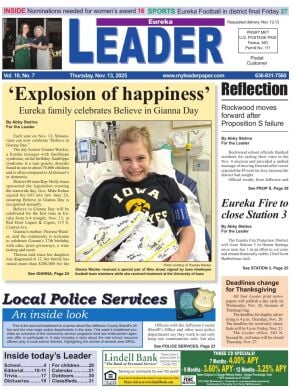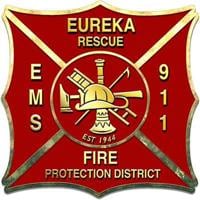Eureka Fire Protection District residents will be asked on April 8 to vote on a tax increase of 34 cents per $100 assessed valuation.
Scott Barthelmass, Eureka Fire’s chief, said the district would use revenue from the increase to raise pay, which would help recruit and retain firefighters; purchase new equipment; fund building repairs; and strengthen the district’s financial stability.
The ballot measure, called Proposition F, needs a simple majority for passage.
The official ballot language reads: “Shall the board of directors of the Eureka Fire Protection District be authorized to levy an additional tax of not more than 34 cents on the one hundred dollars assessed valuation to provide funds for the support of the district?”
The district’s current tax levy is $1.209 per $100 of assessed valuation. If the proposition passes, the levy will increase by 34 cents to $1.549.
If the proposition passes, the owner of a house valued at $200,000 by the Assessor’s Office would pay approximately an additional $129.20 per year, for a total of $588.62 per year in property taxes to the district. Currently, the owner pays about $459.42 per year.
The owner of a house valued at $450,000 by the Assessor’s Office will pay approximately an additional $290.70, for a total of $1,324.40 per year in property taxes to the district. Currently, the owner pays about $1,033.70 per year.
If Prop F passes, Eureka Fire is projected to receive about $2.4 million in additional revenue in 2026, according to a report provided by Barthelmass. In 2027, the district would receive approximately $2.5 million.
The Board of Directors voted unanimously on Dec. 18 to put Prop F on the ballot.
“It’s a well-thought-out plan that allows us to continue to provide the high level of service that our community expects of us,” Barthelmass said. “I think people in the community know, trust and rely on Eureka Fire to provide them with the best services possible. I think we do an incredible job of protecting our community, and we want to keep that service high.”
The district will hold a series of Prop F meetings and open houses at House 1, 4849 Hwy. 109, in Eureka to inform the community about the tax issue and address any concerns. Barthelmass said the open houses are an opportunity for residents to see the district’s firetrucks up close.
The first meeting will be held at 7 p.m. Wednesday, Feb. 19. The first open house will be at 1 p.m. Saturday, March 1.
Recruit and retain
Barthelmass identified staff retention as one of the district’s biggest problems.
Several firefighters are preparing to retire within the next few years, he said, and younger, highly qualified firefighters are leaving for better job prospects elsewhere. The tax increase would allow the district to raise salaries and provide a more competitive salary and benefits package for firefighters.
The district pays between $29,000 and $57,000 to train new firefighters, purchase their gear and send them to the St. Louis Fire Academy, Barthelmass said.
“We hire very skilled people, but being in a very competitive market, they tend to leave because there are so many offers on the table,” Barthelmass said. “To have somebody completely and totally proficient, to be the best firefighter paramedic, it takes about five years (of training). If you hire someone and then lose them, you’re in a continuous process of training.”
If the tax increase passes, the district will hire four additional firefighter paramedics to work at Station 2, 1815 West Fifth St., in Eureka. At times, Barthelmass said the engine at Station 2 is staffed by two people when the minimum should be three.
Additionally, the emergency call volume increased by 9.9 percent last year, he said, raising concerns that the district population is growing faster than Eureka Fire can provide equipment and staff to cover its approximate 63 square miles in Eureka, Hoene Springs and portions of Wildwood and Pacific.
“We need to make sure we’re always getting equipment out the door,” Barthelmass said. “Our call volume has skyrocketed (and) we’re going to continue seeing population growth.”
The district is working to put together a community paramedic program to attempt to reduce some of the 911 calls through prevention, Barthelmass said. Through the program, firefighter paramedics would educate at-risk populations in the district about best practices, such as properly labeling prescription medicine and identifying fall risks around the home.
About 80 percent of the calls the district responds to are for emergency medical services.
Recently, Barthelmass said a few paramedics reached out to him with the idea of attending the monthly senior luncheon held at the Timbers of Eureka, 1 Coffey Park Lane, to provide free blood pressure checks and health screens as part of the community paramedic program.
“We’re never going to run out of 911 calls,” Barthelmass said. “It’s going to continue to increase, but we may actually reduce some of those calls by being proactive.”
Additional expenditures
In preparing to put the tax issue on the ballot, Barthelmass laid out projected capital expenses to board members.
Barthelmass said the House 1 roof will likely need to be replaced for about $100,000 in 2026. That facility holds the district’s administrative offices and board meetings twice a month.
He also said the district will likely need to buy a new inflatable rescue boat for House 3, 3570 Riverbend Road, in Hoene Springs for approximately $35,000, purchase about $412,000 worth of new gear, buy a new staff vehicle for approximately $80,000 and spend about $100,000 for new door locks and cameras.
“We operate a service that is 24 hours, seven days a week, 365 days a year, and get some wear and tear,” Barthelmass said. “When things are bad, when you have flooding, when you have ice storms, when you have snowstorms, those are stressors put on that equipment.”
In 2027, the district plans to replace power loads and stretchers for approximately $140,000, purchase two new brush trucks for a total of about $200,000 and a new duty vehicle for approximately $100,000.
In 2028, the district will replace paramedic monitors and LUCAS devices, which administer chest compressions to cardiac arrest patients when transported to a hospital, for approximately $222,000. The district also plans to purchase a staff vehicle for about $80,000.
“Running a fire department is expensive because the equipment that’s necessary to operate a department, it’s lifesaving equipment, and can’t fail,” Barthelmass said.
In about five years, the district plans to begin remounting three ambulances. Barthelmass said remounting a new chassis on an existing ambulance truck, rather than purchasing a brand-new ambulance, can save the district $150,000 to $200,000 per unit.
Barthelmass said fire engines typically need to be replaced every 12 years, but through preventive maintenance programs, the district can keep trucks in service for about 15 years.
“We’re trying to be good guardians of the money the community is allotting us for protecting them,” he said.
Financial stability
Barthelmass said some of the additional revenue generated from the tax increase would be used to create an emergency fund dedicated to unforeseen problems.
“When you look at most government entities, they strive to have about six months in fiscal reserves,” Barthelmass said. “A month and a half to two is what we have.”
Eureka Fire is a unique district, Barthelmass said, with two rivers flowing through it, two railroads, a major interstate, a prison, an amusement park and a state park. The district must prepare for whatever emergency arises, and part of that preparation is putting the district in a stronger financial position, he said.
“No matter what happens, we need to have the funds available. We need a strong financial reserve,” Barthelmass said.




